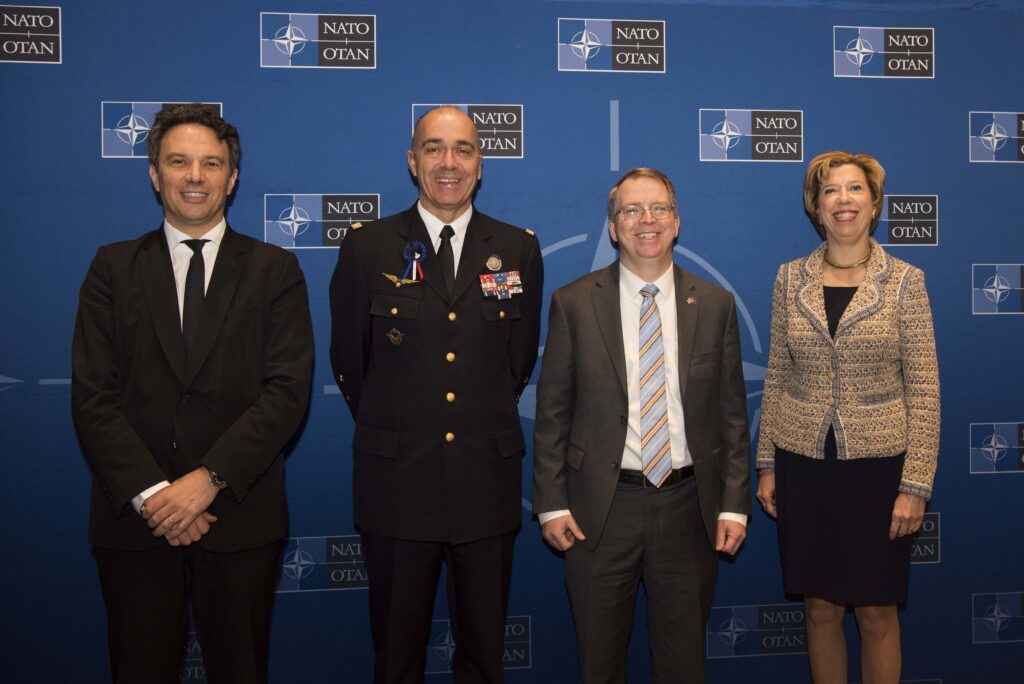
NATO Assistant Secretary General for Defence Investment, Camille Grand, Supreme Allied Commander Transformation, Gen. André Lanata, Deputy Defense Secretary David Norquist, and Defense Undersecretary for Acquisition Ellen Lord at NATO Industry Forum.
WASHINGTON: Two top Pentagon officials today warned the European Union against moving ahead too quickly or forcefully on plans to increase defense spending outside the NATO alliance. The call comes just days after the EU announced 13 new collaborative defense spending projects, including a major effort to build a new patrol corvette and an anti-submarine underwater drone.
Speaking at a NATO defense industry summit, Deputy Defense Secretary David Norquist warned that if the EU continued to fund projects with the $14 billion it has earmarked for defense spending, that “lack of cooperation could lead to duplication of NATO efforts and undermine Trans-Atlantic security.” Calling for more NATO spending, he added the EU “must allow the United States and other non-EU allies to participate and compete for business,” adding Washington “strongly encourage[s] our European allies to pursue efforts that facilitate greater NATO-EU cooperation and advance interoperability.”
At issue is the $14 billion European Defence Fund, and related procurement programs under the Permanent Structured Cooperation, or PESCO, the European economic alliance is undertaking.
On Tuesday, the European Council adopted 13 new collaborative PESCO projects, each led by several countries who pool resources to lead research and production. Overall, there are now 47 PESCO projects in the works, with 25 EU states participating.
In addition to the corvette and the drone, new projects include airborne electronic attack for manned and unmanned aircraft, communications and training equipment and space-based early warning systems.
Asked about PESCO and the European Defense Fund, Pentagon acquisition chief Ellen Lord was diplomatic, telling reporters, “we are working very, very hard to align all of the EU initiatives along with NATO, we want them to be complementary. I think they can be, but there are some concerns with language” in the EU’s documents spelling out its defense spending plans.
Many of Lord’s concerns were spelled out in a forceful letter she and the State Department’s then-undersecretary for arms control and international security, Andrea Thompson, sent in May to EU leadership. The missive argued that language in the EU planning documents favors European defense companies at the expense of US firms. The intellectual property and export control restrictions would act as poison pills to “effectively preclude participation by any company that uses U.S.-origin technology,” the letter said. Lord and Thompson also suggested Washington would consider slapping penalties on EU member states if American companies are shut out.
The White House has also recently complained about the EU’s plans to enact a slew of space development and procurement projects that would block non-EU NATO allies and the US from participating.
European Union officials deny those claims, insisting that all companies, based in EU countries or not, are welcome to participate.
But a major point of concern for NATO is that these new technologies won’t share the same standards, and won’t be interoperable with other NATO equipment.
“I welcome the European efforts on defense,” NATO Secretary General said here this morning. “They have the potential to increase defense spending, provide new capabilities and improve burden-sharing within the alliance. But NATO and the EU need to complement each other. Nations shouldn’t have two sets of capability requirements. Forces and capabilities developed under PESCO, the EU’s mechanism to increase military cooperation among member states, must also be available for NATO. And we need the fullest possible involvement of non-EU NATO Allies.
Since entering office, the Trump administration has demanded that NATO members move more quickly toward the goal of spending 2 percent of their GDP on defense, something only a handful of countries in the 29 member alliance currently achieve. But while the US and Brussels cheer the idea of more being spent in the sector, the non-NATO projects being undertaken by the EU have raised alarms that new capabilities are being developed that would be disconnected from NATO, siphoning funds, and resources, from the alliance as it rushes to modernize.
Northrop sees F-16 IVEWS, IBCS as ‘multibillion dollar’ international sales drivers
In addition, CEO Kathy Warden says the company sees a chance to sell up to five Triton UAVs to the NATO alliance.


























